Presented to Old Jamestown Association by Cindy Winkler, Spring 2012
For more than 150 years, we Americans have been fascinated by the Civil War/War Between the States/The War of Northern Aggression, etc. The war’s prevalence in popular culture tends to go in and out of vogue in movies, books, and TV shows.
However, I believe the war is still a constant presence in the lives of many cradle Southerners. For instance, when I used to work for lawyers, I helped with paperwork needed to get architectural and engineering firms qualified to do business in different states. One state we were applying to was Louisiana. This very helpful woman at the Architectural Board warned me, I guess, to be sure paperwork was completed and approved prior to the client doing any work down there. She told me, “We look out for Yankee Carpetbaggers coming down here and doing work without licensure.” I remember laughing and saying, “Well, I’m calling from Missouri,” you know, not Maine or Michigan or something like that. That seemed to clear the air a little.
And of course, Missouri did secede from the Union….or maybe it would be better to say that we were admitted into the Confederate States of America in November of 1861. Only the Confederate-sympathizing portion of the Missouri government seceded. The loyal Union portion of the state remained a part of the United States of America. It must have been a very confusing time to be a Missouri resident – and politician.
I know out in Western Missouri there are historical markers reminding daily of losses sustained during the Civil War. Jayhawking this or Bushwacking that….. But we don’t have so many around here. The only one I know of off the top of my head is in Portage Des Sioux. It would be easy for us Missourians to forget – or not to know at all – that Missouri saw more battles and skirmishes during the Civil War than any other states except Virginia and Tennessee.
Of course the two major issues that precipitated the war were Slavery and States’ rights. And of course we all know that Missouri was admitted to the union in 1821 as a slave state.
Tonight I’m going to share with you a few things I’ve found with respect to both States’ rights and Slavery, during the time of the Civil War, right here in the Old Jamestown Area. Make no mistake: This is not a scholarly presentation. Think of it as, “History On Ice,” akin to “Disney on Ice,” in that it is for entertainment and basic information only. I do not pretend to be an expert on the Civil War. I enjoy reading about it. Like many others, I am fascinated by it. But quite frankly, for me, looking at Xs on battlefields and memorizing generals’ names and dates has always been tedious and … um… not what I want to know. I want to know how historical events affected regular people who lived through them. Something like looking into the history of mankind rather than the history of civilization.
Anyway. I like to do genealogy, and I feel like I’ve done a little genealogy for the Old Jamestown Area, that I’ll share with you tonight.
I’m going to begin with States’ rights.
Let me start by asking you if you know what Presidents Lincoln, G.W. Bush and Obama have in common? And that is not a setup for a bad joke. Each of these presidents has signed laws allowing the suspension of the protection of habeas corpus, or of the right to be charged if you are arrested. Abraham Lincoln suspended habeas corpus nationally in September 1862, but he suspended that constitutional right a year and a half earlier, at the outbreak of the war, for ‘some Midwestern states’ and Maryland. This was done in conjunction with Lincoln’s enactment of martial law – or military rule. In response to 9/11, the second President George Bush signed into law the Military Commission Act, which contains suspensions of writs of habeas corpus for suspected terrorists, among other things. Obama recently renewed that law. So clearly, some of the issues struggled with a century and a half ago are still relevant today.
But back to 1861-ish. Here’s a refresher for us all:
If you would, please set your clocks back to August 1861. The war has begun just four months earlier. Lincoln has called for 75,000 volunteers to serve for 90 days, and Missouri was to raise four regiments toward that 75,000 troop number. Our southern-leaning Governor Jackson, says uh-uh to raising regiments, and that Missouri is neutral, which makes the Union nervous because of the large number of arms at the St. Louis Arsenal. The arms are then removed from St. Louis to Illinois, with a plan by Jeff Davis to intercept them (which didn’t work). We have had two battles in Western Missouri. We’ve opened the Gratiot Street Prison in St. Louis. Martial Law – Military Rule — is declared in St. Louis on August 14th, 1861. (http://www.civilwarstlouis.com/timeline/index.htm)
And we now have a Provost Marshal in charge of the military rule of our area.
And the Provost Marshal is hearing from the local citizens. And they are investigating and arresting people on the suspicion of being secessionists. Can you imagine the opportunity this must have created for feuding neighbors? It must have been a time of great paranoia, and I am sure it brought out the worst in a lot people.
The Provost Marshal records are available on the Missouri Secretary of State website. They are fantastic. They are voluminous, and they seem to run the gamut from seemingly ridiculous, such as this:

To the far more serious, such as this list of ‘disloyal persons’:

Some of these folks lived in the Old Jamestown area. We will see their names again soon. Here is the actual report that supports this indexed Provost Marshal entry:

Hmmm. Looks like James Ferguson lives in the “Scuffletown” neighborhood. Maybe that was the former name of Shoveltown?
Here’s a good example of families being at complete odds during this war.
Durrett Patterson was a slaveholder in the Old Jamestown Area. His land looks to be not far from the Desloge property/Boeing facility, abutting the Missouri River. He is a son of Elisha and Lucy Patterson, and a grandson of John Patterson, Sr., who settled much of what we call the Old Jamestown area. And Durrett’s got a rap sheet with the Provost Marshal. He’s about 50-55 years old:
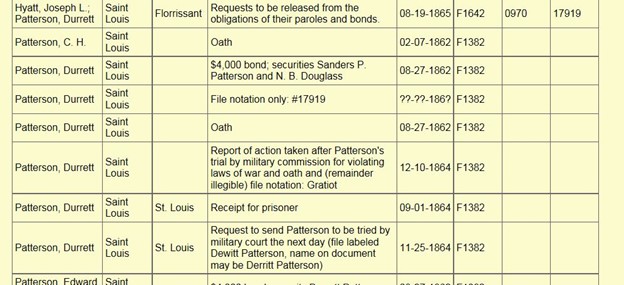
Durrett’s brother, Lewis Patterson, on the other hand, gives a statement against a Rueben Carrico, alleging Rueben is a ‘notorious rebel.’ Carrico is a recognizable name around here; although, this Rueben appears to have lived in a log cabin in Columbia Bottoms. Rueben had to pay $1,000 bond and swear an oath of loyalty to be released from prison.
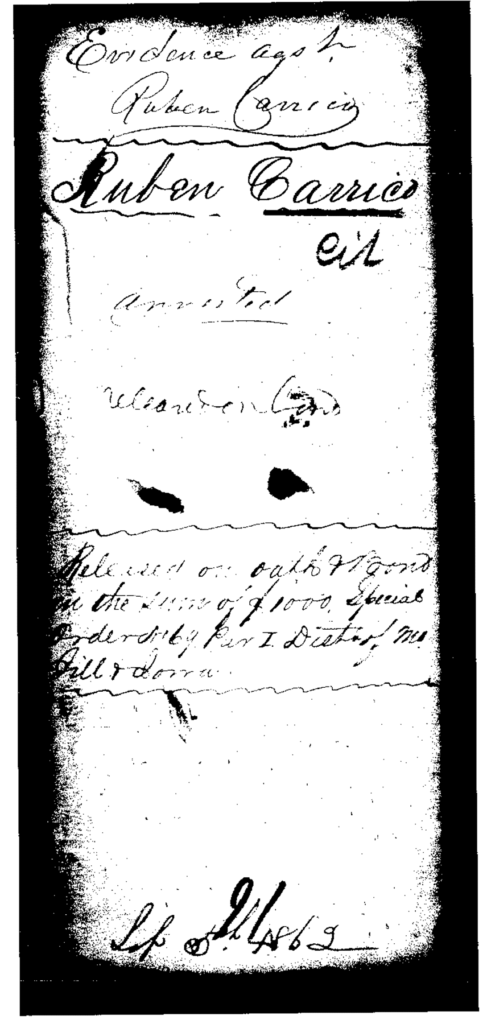
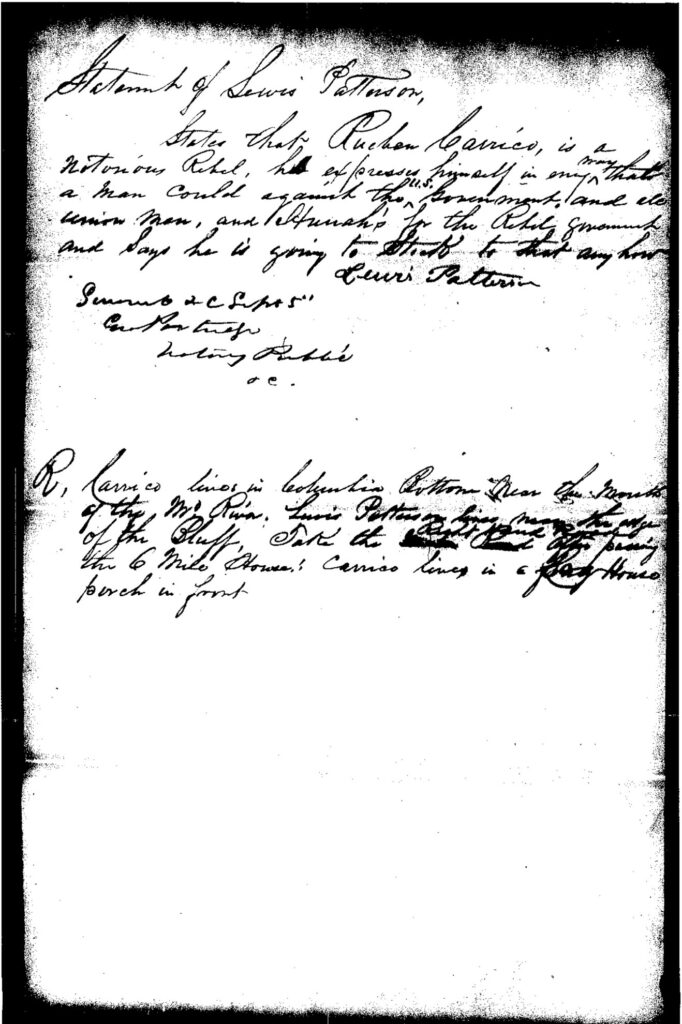
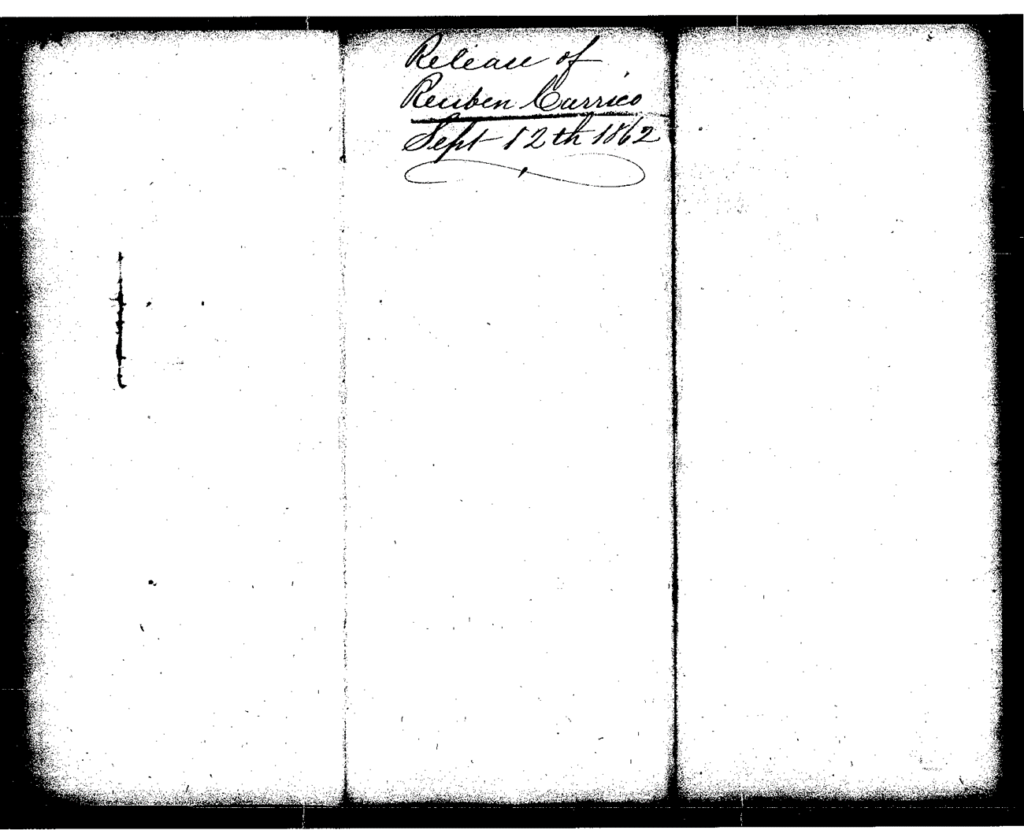
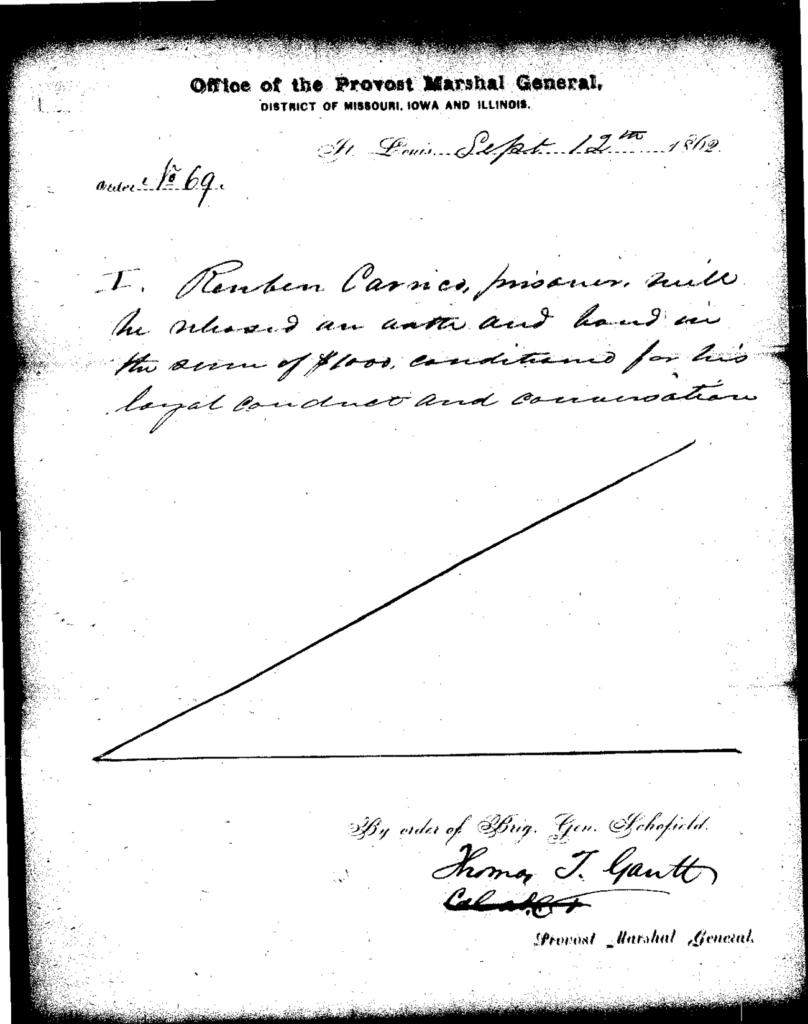
So Lewis Patterson has “informed on” Mr. Carrico, while Lewis’s brother Durrett is out ‘violating laws of war and oath.’
The Patterson Chapter of the DAR owns and maintains the Coldwater cemetery, which is the final resting place for many of the early Florissant Pattersons. I emailed the contact person for the DAR Patterson Chapter, and asked if any of the family members would be willing to contribute any information, letters, pictures, etc., relating to the Civil War, and I also asked about any slaves they owned. The woman was very polite in her email responses, and told me on two occasions that no Patterson descendants owned slaves. Well, there are three listed on the 1860 slave census records, as we’ll see in a minute. Durrett is one of them. I do not find his name on the list of graves at Coldwater Cemetery.
That issue must have divided the Patterson family greatly. I wonder how their mother, Lucy Patterson, dealt with it all, with her family so divided – I would assume bitterly divided. Those are the stories in all of this.
And some of these Provost Marshal records set the stage for how it might have been in the early days of the war here in the “St. Ferdinand Township.”
So let’s say the date is August 28, 1861. St. Louis has been under martial law for two weeks, and what I’m about to read to you transpired two DAYS before the whole state is put under Martial Law. Imagine being awakened by the noise of 50 men on horseback riding by. They are led by Captain Karcher of the 12th Missouri Volunteers, Rifles Division. He’s looking for a cache of arms secreted somewhere around here.
Please let me read Captain Karcher’s report to his superior, Col. Osterhaus, who reports to Major General Fremont. Fremont is in charge of the Army’s Department of the West (West of MS River to California).
He’s in charge of a lot here in August 1861.
Here it is:
Pursuant to an order from headquarters, I with 50 men proceeded to within one and a half miles from Florissant for the purpose of seizing a lot of arms secreted there. I arrived there at one o’clock a.m., August 28th. I was then informed that the arms above mentioned were secreted at a place called Sinks Grocery, about four miles south of the above-mentioned place. I proceeded tither, surrounded the place, and held a general search, but without success. At Sinks Grocery, I arrested three men, named J. Grow, Warren and Thompson, who were pointed out to me as secessionists. J. Grow is a justice of the peace, and reported to be the leader of a company of 40 secessionists. I was then informed that arms were secreted at the residence of Dr. Gibson on the Bellefontaine Road, 8 miles’ distance from St. Louis. I searched his house, but not finding any arms, I started for St. Louis, where I arrived at 8:00 p.m., August 28th, 1861.
Again, this is two weeks after Martial Law is declared in St. Louis, and the citizens are now subject to the control of the provost marshal. I can’t imagine the stress and dis-ease people of this area must have been experiencing. Someone turned these guys in – Dr. Gibson, Warren, Grow, Thompson. Maybe they were rebels with arms, maybe not.
I’ve done a little research on Dr. Gibson, and his place was “Tanglewood,” which must be near Chambers and Bellefontaine Road. It’s now a park, I believe.
I don’t know if the Warren referenced in this report is from the family of Warrens who are near Douglas and New Halls Ferry. I really wanted the Sinks Grocery referred to above to be on Sinks Road, but I think it refers to the owner, Powell Sinks. I am trying to determine if he lived on or had access to one of the Missouri/Mississippi River islands near us here.
I want to say that the Missouri Secretary of State website is where I have obtained a lot of this information. If you like this sort of thing, you should definitely check out the Historian/Genealogist link on the page. It’s fantastic.
~*~
Now on to Slavery in the Old Jamestown Area.
Again, Missouri was a slave state. The Old Jamestown Area is to some extent semi-rural, even now, and must have been the flat-out ‘the country’ in the 1860s. I’ve read the inventory records of a few wills of local citizens in that era, and I believe that then, too, they grew a lot of corn and wheat. There were a lot of farms here.
Please take a look at this map of the Old Jamestown Area from ca. 1868 done by Pitzman’s. I printed and pieced this together from Scott William’s outstanding website called “History’s Time Portal to Old St. Louis.” http://www.usgennet.org/usa/mo/county/stlouis/stlumap.htm
I have highlighted the names of landowners who appeared as Slave owners on the 1860 Census Slave Schedules. The map was published at least 8 years after the 1860 census was done. So please keep that in mind.
The Slave Schedules list the names of the slave owners, not the names of the slaves. They do include some helpful information from a genealogy standpoint, in that they list the slaves’ ages, sex, whether black or mulatto, whether there were any slaves ‘fugitive from the state,’ the number manumitted (freed), and the number of slave houses.
I printed the entire schedule for the St. Ferdinand Census district. The best I can tell, of the 11 pages of the Slave Schedules from 1860, St. Ferdinand Township, two pages can be attributed to the Old Jamestown Area: Pages 3 and 4. There are a total of 148 people listed as slaves on those two pages, and a total of 31 Slave Owners. There were 37 listed slave houses.
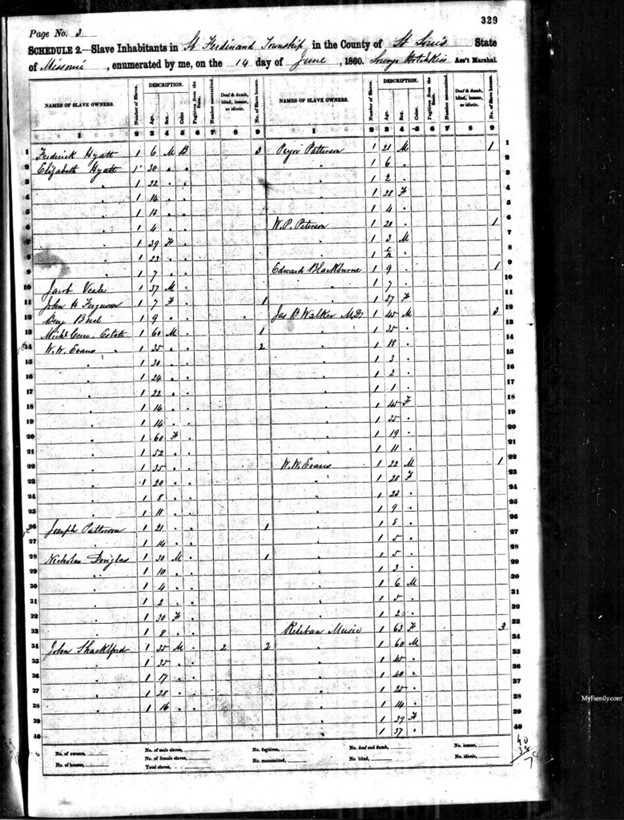
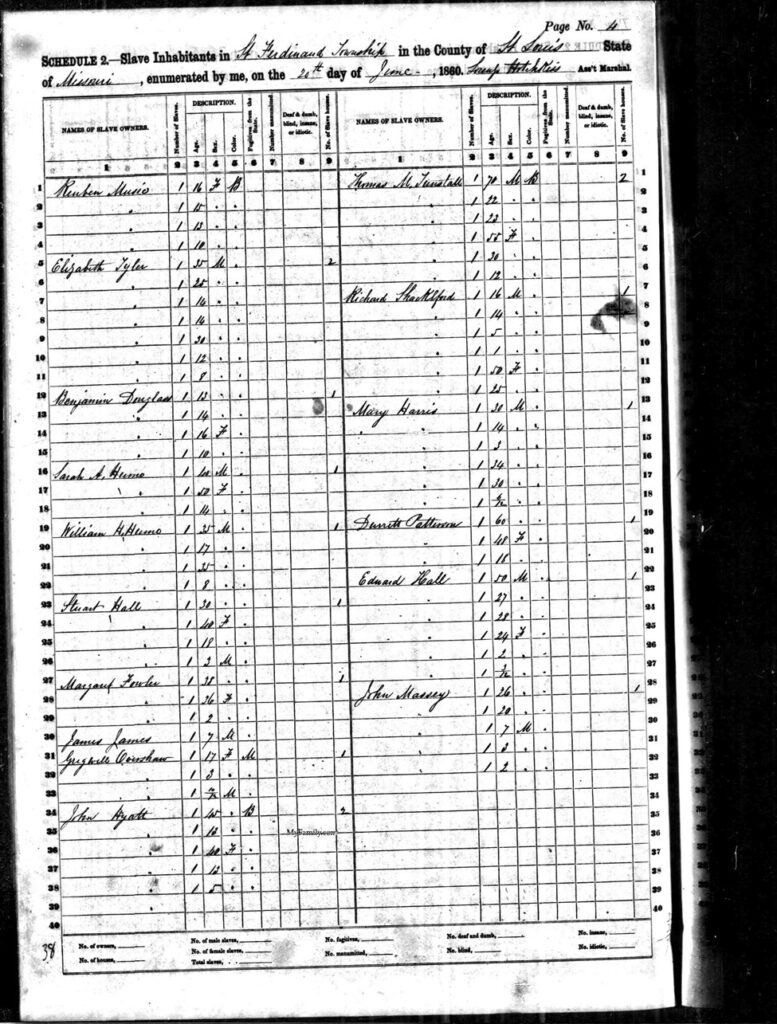
The Dr. Gibson that we talked about earlier as a potential arms trader appears on the list, albeit out of the “Old Jamestown Area” range. Rueben Music, who owned a lot of land in our area, particularly near the Douglas/New Halls Ferry area, owned 12 slaves, and had three slave houses. At the last meeting, I brought in some old prints of photos made in the area in the early 1900s. Many are of small ‘river’ houses down near Musick’s Ferry. Could these be remnants of those slave houses? I wonder…..
I looked at a few of the 1870 census records for those who owned slaves in 1860. Living in the home next to the Valles/Veals (John Veale owned a 37-year-old slave in 1860), I found Harris Hyatt, 40-year-old Black Male, whose age fits that of one of Elizabeth Hyatt’s slaves per the 1860 Slave Schedules. By the way, do you suppose “Veale,” when spoken by an Englishman, might sound a little like “Vail”?
John Ferguson died in 1864. He owned a 7-year-old child per the 1860 Slave Census. The 1870 Census shows Mrs. Mary Ferguson as head of a household that includes one Jasper Evans. His age is consistent with a slave owned by W.W. Evans on the 1860 slave census. Jasper’s wife also lives in the home, and the census shows they were married in November of 1869. That’s a bit of a guess on my part, but it sure looks like Jasper stayed on in the area.
Michael Cerre died in 1859. The 1860 slave census shows one male slave, 60 years old, owned by Cerre’s estate. Mr. Cerre’s will also includes reference to “A Negro man named Frank, around 60 years old.” Cerre’s family were Creoles, and probably had been in the middle Mississippi River valley area since the 1750s. He had a paternal aunt married to Auguste Choteau, and another married to Antoine Soulard. Soulard surveyed a large portion of St. Louis in its early settlement days, including the Old Jamestown area.
It would be interesting to know what happened to the 148 Old Jamestown Area enslaved residents after they were freed. Of course the Emancipation Proclamation did not free the slaves of states that did not officially secede. Freedom from bondage came with the 13th Amendment to the Constitution, which took effect in December 1865.
In closing, we most certainly had all of the elements that tore this country apart right here in 63034. We had families on both sides of the issues of the day, and we had a lot of slaves here. I plan to continue researching what became of the freed slaves, and I would be grateful to hear of anything you all may know about those historical dark times as they may pertain to Old Jamestown. Please feel free to take a look at the research material I have found. I will leave it up here on the table.
Thank you!
Cindy Winkler

